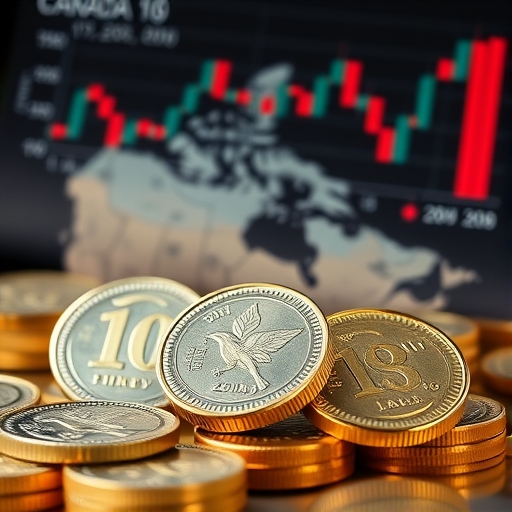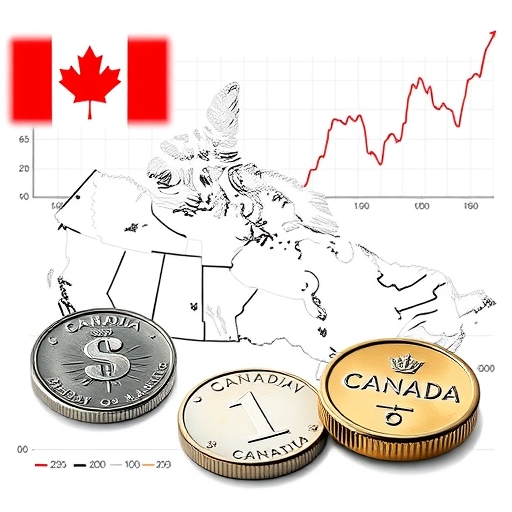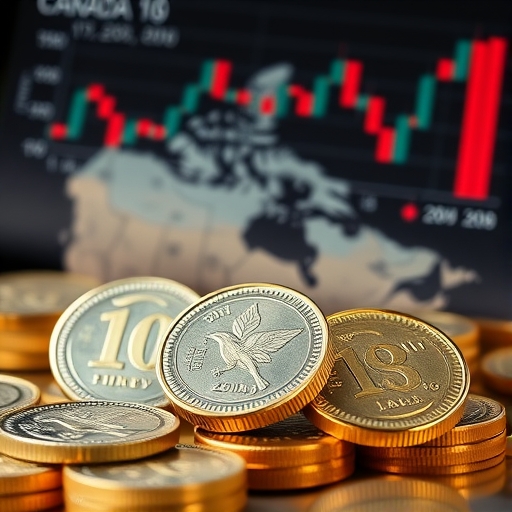“`html
Understanding the C$: Key Drivers and Outlook for the Canadian Dollar
Welcome to this deep dive into the world of the Canadian Dollar, often affectionately known as the ‘Loonie’. If you’re new to investing or seeking to deepen your understanding of currency markets, the C$ is a fascinating case study. Its movements are influenced by a complex interplay of forces, from the resources buried beneath Canadian soil to the decisions made in central banks and the ever-shifting landscape of global trade. Understanding these drivers is absolutely essential for anyone trading or investing in assets tied to the Canadian economy.
We’re here to guide you through the intricacies of what makes the Loonie tick. Think of us as your navigators in the sometimes-choppy waters of currency markets. We’ll break down the key factors in a way that’s professional yet approachable, using a mix of technical terms and relatable examples to help you build a solid foundation of knowledge. By the end, you should have a much clearer picture of why the C$ moves the way it does and what factors you need to keep an eye on.

At its core, the Canadian Dollar (ISO currency code: CAD) is the official currency of Canada. But in the global financial markets, it’s much more than just legal tender. It’s one of the world’s major currencies, widely traded and followed by investors, businesses, and central banks alike. The C$ is particularly significant due to Canada’s position as a major G7 economy and a key trading partner for the United States.
- Global currency status: The C$ is one of the major traded currencies worldwide.
- Exchange rate indicators: Investors watch the CADUSD pair closely.
- Impact on multinational corporations: The strength of the C$ affects Canadian businesses operating internationally.
For investors, the Canadian Dollar’s value against other currencies, particularly the US Dollar (USD), represented by the CADUSD or USD/CAD exchange rate, is a critical indicator. This exchange rate impacts everything from the cost of imports and exports to the relative value of Canadian assets for international investors and the profitability of multinational corporations operating in Canada.
We focus on the C$ not just because it’s a major currency, but because its drivers offer clear lessons in how macroeconomic factors translate into currency movements. Unlike currencies of economies primarily driven by manufacturing or services, the C$ has a strong, unique link to real-world commodities. This makes it a compelling example for understanding the broader forces at play in the global exchange market, often referred to as FOREX.

The Canadian Dollar’s performance is constantly discussed in financial circles. Like all currencies, its value fluctuates based on supply and demand dynamics, which are in turn shaped by economic fundamentals, market sentiment, and external shocks. Looking at the recent past gives us context for understanding the present.
Data often shows the CADUSD pair experiencing periods of significant movement. For example, at times, the CAD has traded near its Year-to-Date (YTD) highs against the greenback. Our data indicates a recent 1-Year Change of +0.62% for CADUSD, suggesting a modest strengthening trend over that period, despite daily volatility.
Below is the historical performance data for the CADUSD exchange rate:
| Date | CADUSD Exchange Rate |
|---|---|
| January 2023 | 0.75 |
| February 2023 | 0.77 |
| March 2023 | 0.76 |
| April 2023 | 0.78 |
| May 2023 | 0.79 |
Comparing the C$ to other currencies within the G10 group (the ten major industrialized nations) also provides insight. There have been instances where the Canadian Dollar has outperformed eight out of ten other G10 currencies, showcasing relative strength. However, it’s not a one-way street. We’ve also seen the CAD pull back against a firmer USD or even decline against other major currencies, highlighting the dynamic nature of the FOREX market.
These fluctuations aren’t random. They are the market’s reaction to new information about Canada’s economy, global events, and the relative attractiveness of investing in CAD-denominated assets versus those in other currencies.
Understanding the Canadian Dollar fundamentally requires understanding two bedrock pillars of the Canadian economy and financial policy: commodities and interest rates.

Canada is globally recognized as a major producer and exporter of natural resources. This isn’t just trivia; it’s a defining characteristic of the economy and a primary driver of the Canadian Dollar’s value. Key commodities influencing the CAD include:
- Oil and Natural Gas: As a major energy producer, Canada’s economy, and thus its currency, are highly sensitive to fluctuations in global energy prices. When oil prices rally, it generally benefits Canadian exports, increases export revenues, and can lead to foreign capital inflows, supporting the CAD. Conversely, falling energy prices tend to weigh heavily on the Loonie.
- Metals and Minerals: Gold, copper, nickel, and other metals also play a role. Gold, in particular, is sometimes seen as a safe-haven asset, and its price movements can correlate with broader market sentiment that also impacts currencies.
- Agricultural Products: Wheat, lumber, and other resource-based exports contribute to Canada’s trade balance, which is a factor in currency valuation.
Because of this strong link, the Canadian Dollar is often referred to as a ‘commodity currency‘. This means its value often tracks the price movements of key commodities, especially oil. Monitoring global commodity markets is therefore crucial for anyone looking to understand or predict CAD movements.
The other monumental influence on the CAD is monetary policy, dictated primarily by the Bank of Canada (BoC). Like other central banks, the BoC sets key interest rates with the goal of managing inflation and supporting economic growth.
- Interest rate influence: Changes in BoC rates can lead to currency appreciation or depreciation.
- Capital flows: Higher rates attract foreign investment, impacting the CAD positively.
- Comparison with the Fed: The monetary policy of the US Federal Reserve affects Canadian monetary policy and the CAD.
Interest rates are paramount in currency markets because they affect the return investors can earn on holding a currency. If the BoC raises interest rates relative to other central banks, it makes CAD-denominated assets (like bonds or bank deposits) more attractive to foreign investors seeking higher yields. This increased demand for CAD assets translates into increased demand for the Canadian Dollar itself, potentially causing it to appreciate.
Conversely, if the BoC lowers rates, or if other central banks raise theirs faster, the yield advantage diminishes or reverses, potentially leading to capital outflows and CAD depreciation. Therefore, BoC rate decisions are always major market events, eagerly awaited by investors and traders globally. Statements accompanying these decisions, providing forward guidance on the bank’s outlook, are scrutinized for clues about future policy direction.
However, the BoC doesn’t operate in a vacuum. The monetary policy of the US Federal Reserve (Fed) is equally, if not more, influential, particularly on the CADUSD pair. Since the US is Canada’s largest trading partner and the USD is the world’s primary reserve currency, Fed interest rate decisions and their outlook for the US economy have a profound impact on global capital flows and the relative strength of the USD.
The ‘interest rate differential‘ – the difference between interest rates in Canada and the United States – is a key factor driving investment decisions and, consequently, the CADUSD exchange rate. If Canadian rates are higher than US rates, it can support the CAD. If US rates are higher, it often strengthens the USD against the CAD.
Market participants constantly assess the economic outlook in both countries and anticipate whether the BoC might raise or lower rates before the Fed does, or vice versa. Discussion around one central bank potentially “outdoving” (adopting a more dovish, or lower-interest-rate, stance) the other can significantly influence expectations and currency movements. Economic data like US CPI (Consumer Price Index) is closely watched as it informs expectations about potential Fed rate adjustments.
While commodities and interest rates are fundamental, external factors – particularly related to global trade and geopolitics – have become increasingly significant drivers of currency volatility, and the Canadian Dollar is no exception.
Canada’s economy is highly integrated with that of the United States, primarily through trade. This makes the CAD particularly vulnerable to changes in US trade policy. Measures such as tariffs imposed by the US on Canadian goods, or vice versa, can directly impact trade volumes, supply chains, and the profitability of industries on both sides of the border. For instance, tariffs affecting Canada’s crucial auto industry can have widespread economic consequences.
- Market chaos: Tariffs often create uncertainty that affects market sentiment.
- Trade wars: Disputes between major countries can ripple through Canadian markets.
- Domestic policies: Political stability can influence investor confidence in the CAD.
When tariffs are imposed or threatened, it creates “chaos and uncertainty” in the market, as noted by analysts. This uncertainty often leads to risk aversion, which can weigh on currencies perceived as more vulnerable. Court rulings challenging or upholding these tariffs also inject volatility, as market participants react to potential shifts in the trade landscape.
Trade wars, particularly between major global players like the US and China, can have ripple effects. While the Canadian Dollar’s free-floating exchange rate is often seen as a buffer that helps Canada absorb external shocks, trade disputes can still make the CAD more vulnerable compared to currencies of economies less reliant on intricate cross-border supply chains, such as the Mexican Peso in certain contexts.
Beyond direct trade policies, broader geopolitical developments also play a role. Progress or tensions in significant international talks, such as US-China trade discussions, influence global risk appetite. Positive developments can boost confidence and encourage investment in riskier assets, potentially supporting commodity currencies like the CAD. Conversely, escalating tensions can trigger risk-off sentiment, strengthening safe havens like the USD or Gold and weighing on the CAD.
Domestic political stability within Canada can also affect market sentiment towards the CAD. Outcomes of Canadian federal elections, for instance, especially if they result in a minority government or significant policy uncertainty, can lead to increased caution among investors. Similarly, political developments and commentary in the United States, particularly from influential figures whose policies might impact trade or economic relations with Canada, are closely watched and can trigger CAD movements.
In essence, the C$ doesn’t exist in isolation; it’s buffeted by global economic and political winds. Staying informed about international relations and major policy shifts is therefore an integral part of understanding the Loonie’s trajectory.
Financial markets are not just driven by objective economic data; they are also heavily influenced by collective psychology – what we call market sentiment. This sentiment reflects the prevailing attitude of investors and traders towards a particular asset or market, whether bullish (optimistic) or bearish (pessimistic).
- Analyst forecasts: Insights from leading analysts can shift market sentiment.
- Institutional positions: Large institutions often set market trends based on their trading behavior.
- Market chatter: Noise in the market can also influence investor behavior.
Market sentiment towards the Canadian Dollar is a crucial factor in its day-to-day and even longer-term movements. Analyst forecasts, trading positions taken by large institutions like hedge funds, and general market chatter all contribute to this sentiment.
For example, you might hear analysts from major banks or research firms like Citigroup, Scotiabank, or Rosenberg Research offering differing views on the CAD’s outlook. Some might view a recent CAD surge as a temporary “mirage,” while others might declare that the “worst is over” for the currency. These varied perspectives reflect different interpretations of the economic drivers and different trading strategies.
Understanding market sentiment requires paying attention to:
- Reports and analysis from reputable financial institutions.
- Commentary from prominent economists and strategists.
- Data on speculative positioning (like the CFTC’s Commitment of Traders report, although that’s more advanced).
- Overall risk appetite in global markets (whether investors are favoring ‘risk-on’ assets like stocks and commodities or ‘risk-off’ assets like safe-haven currencies).
While sentiment can sometimes push a currency away from its fundamental value in the short term, over the long run, fundamentals tend to reassert themselves. However, identifying shifts in sentiment can provide valuable clues for short-to-medium term trading decisions.
If you’re looking to gain exposure to the Canadian Dollar, either for speculative purposes, hedging currency risk, or simply as part of an investment strategy, there are several instruments available. The most common way to trade currencies is through the FOREX (Foreign Exchange) market.
In the spot FOREX market, currencies are traded directly with immediate settlement. The most liquid pair involving the CAD is the USD/CAD or CADUSD pair. Trading FOREX typically involves going long (buying) one currency and short (selling) another simultaneously. For example, buying CADUSD means you are buying Canadian Dollars and selling US Dollars, betting that the CAD will appreciate against the USD.
Beyond the spot market, listed futures and options contracts are popular choices, particularly for institutional investors and experienced traders. Exchanges like CME Group offer highly liquid and regulated contracts for the CAD/USD pair. Trading futures involves an agreement to buy or sell a specific amount of currency at a predetermined price on a future date. Options give the buyer the right, but not the obligation, to buy or sell a currency pair at a specific price (the strike price) before or on a certain date.
These listed instruments offer several advantages, including centralized clearing (mitigating counterparty risk) and often greater transparency. They can also provide capital efficiencies through leverage, though it’s crucial to understand that leverage magnifies both potential profits and losses.
If you are considering trading the Canadian Dollar or exploring other instruments like Contracts For Difference (CFDs) based on currencies or other assets, choosing the right platform is a critical first step.
If you’re considering starting FOREX trading or exploring more CFD products, then Moneta Markets is a platform worth considering. Originating from Australia, it offers over 1000 financial instruments, suitable for both novice and professional traders.
When trading the CAD, it’s important to consider the typical trading hours when the market is most active (overlap between North American and European sessions often sees higher volatility and liquidity). You’ll also want to understand the concept of spreads (the difference between the buy and sell price) and potential commission costs, which vary between brokers and platforms.
Given the range of factors influencing the Canadian Dollar – from fluctuating commodity prices and central bank decisions to sudden trade policy announcements and shifts in market sentiment – the CADUSD pair can experience significant volatility. For traders and investors, understanding and managing this volatility is paramount.
Volatility is a measure of how much the price of an asset fluctuates. High volatility means prices can change dramatically in short periods. The Canadian Dollar CVOL Index is one tool used by professionals to track the implied volatility of CAD options, giving insight into market expectations for future price swings.
Ignoring volatility is risky. A strong understanding of risk management techniques is essential for protecting your capital. Here are some key considerations:
- Position Sizing: Determine how much capital you are willing to risk on any single trade or investment. Never allocate an excessive portion of your portfolio to a single currency position, especially one tied to volatile drivers.
- Stop-Loss Orders: These are instructions to automatically close a trading position if the price moves against you to a certain level. This helps limit potential losses.
- Hedging Strategies: For businesses or investors with significant CAD exposure, hedging can mitigate currency risk. This might involve using forward contracts, futures, or options to lock in a future exchange rate.
- Diversification: Holding assets denominated in different currencies can help spread risk.
- Understanding Leverage: While leverage can amplify gains, it also magnifies losses. Use leverage cautiously and ensure you understand the margin requirements and potential for margin calls.
Choosing a trading platform that facilitates effective risk management is also important. Look for platforms that offer features like guaranteed stop-losses (though these may come with a cost), negative balance protection, and clear margin requirements.
When choosing a trading platform, Moneta Markets‘ flexibility and technological advantages are worth mentioning. It supports popular platforms like MT4, MT5, and Pro Trader, combined with high-speed execution and low spread settings, offering a good trading experience.
Effective risk management isn’t just a set of tools; it’s a disciplined approach to trading. It requires constant monitoring of market conditions, understanding your own risk tolerance, and sticking to your predefined trading plan.
Predicting currency movements with certainty is impossible, but by understanding the key drivers we’ve discussed, you can form a more informed view on the potential trajectory of the Canadian Dollar. Looking ahead, several factors will continue to be paramount:
- Commodity Price Trends: Will oil prices continue to rally or pull back? What is the global demand outlook for other key Canadian exports? Persistent strength or weakness in commodity markets will likely translate directly into CAD performance.
- Monetary Policy Decisions: The pace and timing of interest rate changes by the Bank of Canada and the US Federal Reserve will remain central. Pay close attention to official statements, economic forecasts from the banks, and inflation data in both countries.
- Global Trade Developments: Any news regarding tariffs, trade agreements, or the ongoing relationship between major trading blocs will influence global risk sentiment and the CAD. The outcome of significant international trade talks warrants close monitoring.
- Economic Growth Outlook: How is the Canadian economy performing? What is the outlook for the US and global economies? Money tends to flow towards economies offering stronger growth opportunities, which can support their currencies. Discussions about recession risks in the US, for instance, are relevant for the USD/CAD pair.
- Political Landscape: While perhaps less volatile than economic data, significant political developments in Canada or its major trading partners can still influence market confidence and the CAD.
Keeping track of these intertwined factors will provide you with the context needed to understand the news headlines and market reactions related to the Canadian Dollar. Remember that these drivers can sometimes conflict, leading to periods of choppy, directionless trading, while at other times, multiple factors might align to create strong trends.
The Canadian Dollar is a dynamic and fascinating currency, deeply connected to Canada’s unique economic structure and the broader global financial system. We’ve explored its key drivers, from its identity as a commodity currency sensitive to oil prices, to the critical influence of central bank interest rate policies set by the Bank of Canada and the US Federal Reserve.
We’ve also highlighted how external forces like international trade policies, tariffs, geopolitical events, and shifts in market sentiment can significantly impact the Loonie’s value. For anyone involved in trading or investing in the Canadian market, understanding this complex web of influences is not merely academic; it’s essential for making informed decisions.
Whether you are tracking the CADUSD exchange rate for business, investment, or trading purposes, remember that continuous learning and careful analysis are your most valuable tools. By keeping an eye on commodity markets, central bank communications, global trade news, and market sentiment, you equip yourself with the knowledge needed to navigate the world of the Canadian Dollar more effectively. We hope this deep dive has provided you with a solid foundation for your journey.
what is c$ currencyFAQ
Q:What is the significance of the Canadian Dollar in the global economy?
A:The Canadian Dollar is a major currency, actively traded and essential for international trade, particularly due to Canada’s natural resources.
Q:How do commodity prices affect the value of the Canadian Dollar?
A:As a commodity currency, the CAD’s value is closely linked to the prices of key exports like oil and minerals; higher commodity prices typically strengthen the CAD.
Q:What role does the Bank of Canada play in currency valuation?
A:The Bank of Canada sets interest rates that influence inflation, economic growth, and investment attractiveness, directly impacting the value of the CAD.
“`

留言